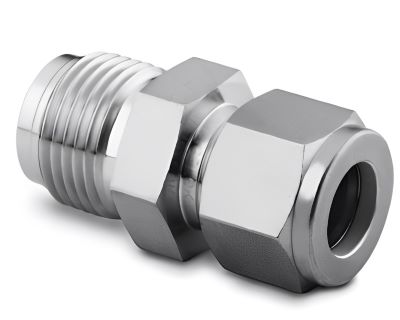In industries where fluid containment is paramount, VCR connections stand out as the gold standard for ensuring leak-free performance. These specialized fittings offer exceptional reliability and durability, making them an indispensable component in various applications.
Join us as we delve into the world of VCR connections, exploring their unique features, benefits, and applications. Discover why VCR connections are the preferred choice for engineers and technicians seeking to maintain leak-proof fluid systems.
What is a VCR Connection?
A VCR (Vacuum Compression Ring) connection is a type of pipe fitting designed to create a reliable, leak-free seal between two pipes or components. It’s widely used in industries where fluid containment is critical, such as oil and gas, pharmaceuticals, and chemical processing.
Components of a VCR Connection
A typical VCR connection consists of three primary components:
1. Body: The main part of the fitting, which houses the gasket and nut.
2. Gasket: A circular seal that provides the primary barrier between the two connected pipes.
3. Nut: A threaded component that compresses the gasket against the body and the other pipe, creating a tight seal.
How VCR Connections Work
VCR connections work on the principle of compression. When the nut is tightened, it compresses the gasket against the body and the other pipe, creating a mechanical seal that prevents fluid leakage. The gasket’s material and design are critical in ensuring a reliable seal.
Why VCR Connections Are Ideal for Leak-Proof Systems
VCR connections are designed to withstand high pressures without compromising the seal integrity. Their unique design and the use of high-quality materials make them ideal for applications where fluid leakage can have serious consequences.
Compatibility with Hazardous and High-Purity Fluids
VCR connections can be used with a wide range of fluids, including hazardous substances and high-purity liquids. The choice of gasket material and body material is crucial in ensuring compatibility and preventing contamination.
Corrosion Resistance and Durability
VCR connections are typically made from materials that are highly resistant to corrosion, such as stainless steel. This durability ensures long-lasting performance and minimizes maintenance requirements.
Types of VCR Connections and Their Applications
There are two main types of VCR connections:
1. Single Ferrule: This type uses a single ferrule to create the seal. It can be used for a lot of applications.
2. Double Ferrule: This type uses two ferrules, providing additional support and security. It’s often used in high-pressure or critical applications.
Choosing the Right VCR Connection for Specific Fluid Systems
The choice between single and double ferrule VCR connections depends on factors such as the fluid type, pressure requirements, and the specific application. Consulting with a fluid system expert can help you select the most appropriate type.
Common Industries Using VCR Connections
VCR connections are widely used in various industries, including:
➡️ Oil & Gas: For pipelines, valves, and other components.
➡️ Pharmaceuticals: For manufacturing and processing equipment.
➡️ Chemical Processing: For handling hazardous and corrosive substances.
➡️ Semiconductor Manufacturing: For cleanroom applications.
Installation Best Practices for VCR Connections
Preparing the Connection:
Before installing a VCR connection, ensure that the components are clean and free of debris. Proper alignment is also essential for a reliable seal.
Correct Torque Application:
Applying the correct torque to the nut is crucial for achieving an optimal seal. Undertightening can result in leaks, while overtightening can harm the gasket. Consult the manufacturer’s specifications for the recommended torque values.
Avoiding Common Installation Mistakes:
➡️ Over-tightening: This can damage the gasket and reduce its effectiveness.
➡️ Misalignment: Ensure that the pipes and components are properly aligned before tightening the nut.
Troubleshooting Issues with VCR Connections
Identifying Signs of a Poor Seal:
➡️Leaks: Look for visible fluid leaks around the connection.
➡️ Pressure Drops: If there’s a pressure drop in the system, it could indicate a leak or a problem wi th the seal.
Fixing Cross-Threading and Misalignment Issues:
If the connection is cross-threaded or misaligned, it may need to be disassembled and reassembled correctly.
When to Replace vs. Repair:
If the gasket is damaged or the components show signs of significant wear, it may be necessary to replace the entire connection. However, in some cases, repairing the connection by replacing the gasket or other components may be sufficient.
Comparing VCR Connections to Other Fitting Types
VCR Connections vs. Compression Fittings:
While both VCR connections and compression fittings are used to create seals, VCR connections offer several advantages, including:
➡️ Higher pressure ratings
➡️ Better leak resistance
➡️ Greater versatility
Why Choose a VCR Connection Over a Welded Joint?
VCR connections are often preferred over welded joints in applications where:
➡️ Repairability is important
➡️ Flexibility is required
➡️ Cost-effectiveness is a concern
Cost vs. Performance:
While VCR connections may have a higher initial cost compared to some other fitting types, their long-term performance and reliability often justify the investment.
Tips for Maintaining VCR Connections in Fluid Systems
Regular Inspections:
Periodically inspect VCR connections for signs of wear, damage, or leaks. This can help identify and address potential problems before they escalate.
Proper Cleaning and Reassembly Techniques:
When disassembling a VCR connection for maintenance or repair, ensure that the components are thoroughly cleaned to remove any contaminants. Follow the manufacturer’s instructions for reassembly.
Prolonging Gasket Lifespan:
➡️Store gaskets properly: Keep gaskets in a clean, dry environment.
➡️ Avoid excessive handling: Reduce handling to avoid damage.
➡️ Select the right gasket material: Choose a gasket material that is compatible with the fluid and operating conditions.
Conclusion
VCR connections are an essential component of many fluid systems, providing reliable and leak-free performance. Their versatility, durability, and compatibility with a wide range of fluids make them the gold standard for critical applications.
By understanding the basics of VCR connections, following installation best practices, and conducting regular maintenance, you can ensure the optimal performance of your fluid systems.
Post time: Oct-03-2024


